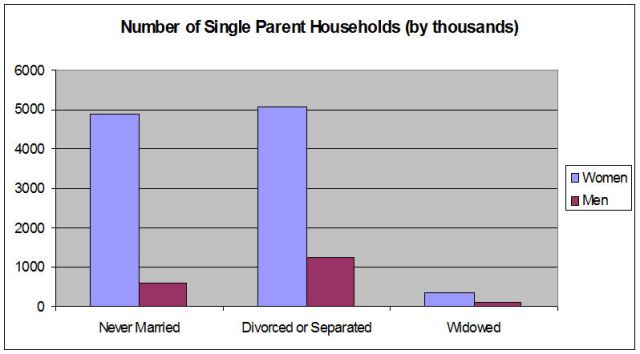Currently, according to 2012 data, there are about 12,279,000 single parent households in the United States. The vast majority of them are headed by women, as can be seen in the chart below: 

What we immediately notice is that single-family households are dominated by households headed by women, with an almost even split between the never-married and the divorced or separated. Looking at the income of single family households, We see that almost half of all single-parent households headed by women (45.6%) have a household income of just over $2000 per month. Included in the census definition of income is child support, alimony, federal and state benefits and other income. This is an important distinction because “income” as described by the Census Bureau goes beyond even the IRS definitions of taxable income, to include literally all monies received. The only thing (and a major error in our thinking) missing is imputed income, such as in cases in which the ex-wife lives in the home purchased by her ex-husband and he is required to continue paying the mortgage. Another example is the state-run health-care programs for children that operate on an ad hoc basis, essentially for free. There is no accounting for these benefits, which would cost a significant amount if purchased on the open market.
Looking at the cohort with income of less than $10,000 per year, if we assume two children, the SNAP benefits would be over $500 per month and going by median child support payments, the family would be receiving some $600 per month in child support. This $1100 per month in just SNAP and child support comes out to $13,200 per year. In other words, a significant number of single-parent households are supported entirely by the father of their children and the state. In this case, the state is using its police powers to expropriate money from the biological father.
Notice in the chart below that if we back out the $13,200 per year in combined SNAP benefits and median child support, almost 30% of single parent homes headed by women are below $10,000 in income and over half of these families have earnings of less than $25,000 per year. This is only considering SNAP benefits, but there are many other programs as well, including medical insurance for the children (such as the Well Kids program) that account for an ‘on demand’ benefit that would otherwise cost a significant amount of money each month.
No such allowance was made for households headed by men, because on the low end of the scale men receive no statistically significant child support from women and tend not to apply for or receive welfare benefits. There is very much a double standard for men and women in family court as witnessed by the fact that women receive primary custody of the children 80% of the time. Anecdotal evidence indicates only men who are able to hire competent counsel and afford investigative services to prove the woman is less fit than they are to receive custody are actually able to gain custody, such is the power of the bias against men.
As can be seen by the chart above, single, divorced and separated mothers are effectively married to the state. In contrast, 41.7% of all single-parent households headed by men have an income of greater than $50,000. Perhaps the reasonable way to view this chart is that only men with enough money to afford good counsel and investigative services are able to gain custody of their children in the current legal environment.
The next chart, which compares the earnings of men fifteen years of age and older, comparing married men to men who are either never married, separated, divorced or widowed, we see that married men have a strong tendency to earn more than their never-married or no-longer married counterparts.
From age fifteen and up, many men will spend some ten years pursuing an education (effectively investing in themselves) without earning any income. Note that the percentages listed in this chart are of all men. Thus, just below 14 percent of all men who have no earnings are married, a percentage only surpassed by the cohort of married men earning $40,000 to $75,000 per year. Given the economy and long-term unemployment of many men, it is believed chronic unemployment and a shift to grey-market employment accounts for the significant percentage of married men with no official earnings.
The “not married” men in the chart above are the men typically paying child support and alimony. Once past $25,000 per year, married men consistently out-earn not-married men in every category, especially the $40k-$75k quintile. One inference that might be drawn from this chart is that the not-married men do not have as much incentive to earn more money as their married peers do, given that increases in earnings will result in increased child support and alimony payments.
If one accepts that the destruction of marriage creates a disincentive for men to be productive, this is proof that feminism is destroying the US economy.







One thought on “Following The Money…”